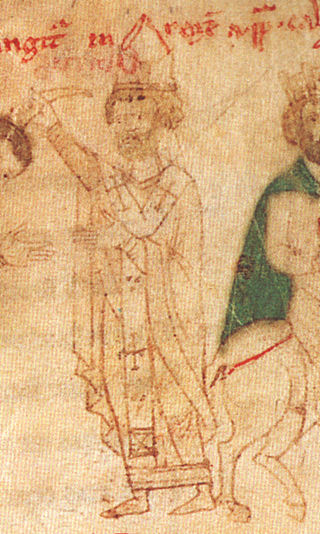Victor IV was an antipope for a short time, from March to 29 May 1138.
John of Crema was an Italian papal legate and cardinal. He was a close supporter of Pope Callistus II.

The 1119 papal election was, of all the elections currently considered legitimate by the Roman Catholic Church, the smallest papal election of the twelfth century.
Oderisio di Sangro was an Italian Benedictine monk and cardinal, the son of Count Rinaldo of the family of the conti di Sangro in the Marsi.
Pietro Senex was Cardinal-Bishop of Porto from 1102 until his death. He was born probably in Rome.

The 1118 Papal Election was held to choose the successor for Pope Paschal II, who died in Rome on 21 January 1118, after an 18-year pontificate. Pope Gelasius II was elected as his successor. The election happened during the Investiture Controversy, a conflict between supporters of the Papacy and those of the Holy Roman Emperor. The election was held under the threat of possible violence due to the controversy. The Cardinal electors took refuge in the Benedictine monastery, S. Maria in Pallara, during the election. Within minutes of his election as pope, Gelasius II was attacked and imprisoned by the Frangipani faction, supporters of the Holy Roman Emperor. Gelasius managed to escape, but at the emperor's arrival with his army, he fled Rome and never returned.
Deusdedit was the cardinal-priest of San Lorenzo in Damaso from 1116 until his death. He was named a cardinal by Pope Paschal II. Nothing is known of his life before he was a cardinal. He is not the canonist Balius Severinus Deusdedit, appointed cardinal priest of the Roman titular church Apostolorum in Eudóxia by Pope Gregory VII.
Roscemanno, O.S.B.Cas. was a Roman Catholic Cardinal and Deacon of San Giorgio in Velabro.
Petrus Pisanus was a Roman Catholic Cardinal. He began his career in papal service as a scriptor in the chancellery. He was appointed Deacon of San Giorgio in Velabro, and then promoted Cardinal-priest of Santa Susanna. He served briefly as papal legate in Corsica, before becoming a permanent member of the papal court. He participated in the papal elections of 1118, 1124, and 1130. In 1130, he chose to support the Obedience of Anacletus II rather than that of Innocent II. After Anacletus died in 1138, he joined the Obedience of Innocent II, and survived the purge of 1139.
Bonifacius was a Roman Catholic Cardinal and Cardinal-priest of the titulus of San Marco. In 1111, he was one of the cardinals captured by King Henry V at what was supposed to be his coronation, and was held prisoner near Rome along with the pope for sixty-one days. He was forced to subscribe to the oath taken by Pope Paschal II, according to the dictates of King Henry. He was then one of the cardinals who opposed the agreements struck by Paschal with Henry in the Lateran synod of 1112. He was not one of the cardinals who followed popes Gelasius, Calixtus, or Honorius on their travels. In the contested papal election of 1130, he supported Pope Anacletus II.
Divizo was a Roman Catholic Cardinal and Cardinal-priest of the titulus of Santi Silvestro e Martino ai Monti, originally called the titulus Equitii. In 1108, he was papal legate to Germany. He opposed the conciliatory policy of Pope Paschal II to the German King Henry in the Investiture controversy, was imprisoned with the pope and fifteen other cardinals, and forced to sign papal agreements. He then worked against them in the Roman synod of March 1112. After the synod, he was sent to Germany as a legate to Henry V, to work out a compromise. In the winter of 1121 he was promoted Cardinal-bishop of Tusculum (Frascati).
Desiderius was a Roman Catholic Cardinal, and Cardinal-priest of the titulus of S. Prassede in Rome.
Benedictus was a Roman Catholic Cardinal, and Cardinal-priest of the titulus of San Pietro in Vincoli in Rome, also called the titulus Eudoxiae.
Anastasius was a Roman Catholic Cardinal, and Cardinal-priest of the titulus of S. Clemente in Rome.
Saxo de Anagnia was a Roman Catholic Cardinal, and Cardinal-priest of the titulus of S. Stefano al Monte Celio in Rome. He was a native of Anagni, and a member of the family of the Conti di Anagni. Dumas points out that there is no positive evidence of the family connection.
Gregorius was a 12th century Roman Catholic Cardinal, and Cardinal-priest of the titulus of San Lorenzo in Lucina in Rome. A remark by Hugh the Chanter of York appears to indicate that he was a native of Siena. Rudolf Hüls, however, notes that Hugh might have mistaken Gregory of San Lorenzo and Gregory of Santa Prisca. Alfonso Chacón (Ciaconius) calls him Gregorius de Ceccano, a Hernician of the diocese of Aquino. Lorenzo Cardella says that Gregorius was born in Ceccano in the diocese of Sora, "da nobilissima famiglia". There is no evidence whatever that Gregorius of San Lorenzo was a member of the Albergati family of Bologna.
Amicus, O.S.B. was a 12th century Roman Catholic Cardinal, and Cardinal-priest of the titulus of Ss. Nereo ed Achilleo in Rome.
Joannes was a 12th century Roman Catholic Cardinal, and Cardinal-priest of the titulus of Santa Cecilia in Trastevere in Rome. Alfonso Chacón writes that he was a member of the Capizucchi family, but he was deceived by the forgeries of Alfonso Ceccarelli, a contemporary acquaintance. In fact, according to Agostino Paravicini Bagliani, in the 11th and 12th centuries the Capizucchi family had no cardinals.
Theobaldus was a 12th century Roman Catholic Cardinal, and Cardinal-priest of the titulus of Ss. Giovanni e Paolo in Rome. He is given a second name, Teuto, by Alfonso Chacón, but Teuto was actually a predecessor of Theobaldus at Ss. Giovanni e Paolo.
Rainerius was a 12th-century Roman Catholic Cardinal, and Cardinal-priest of the titulus of Ss. Marcellino e Pietro in Rome.